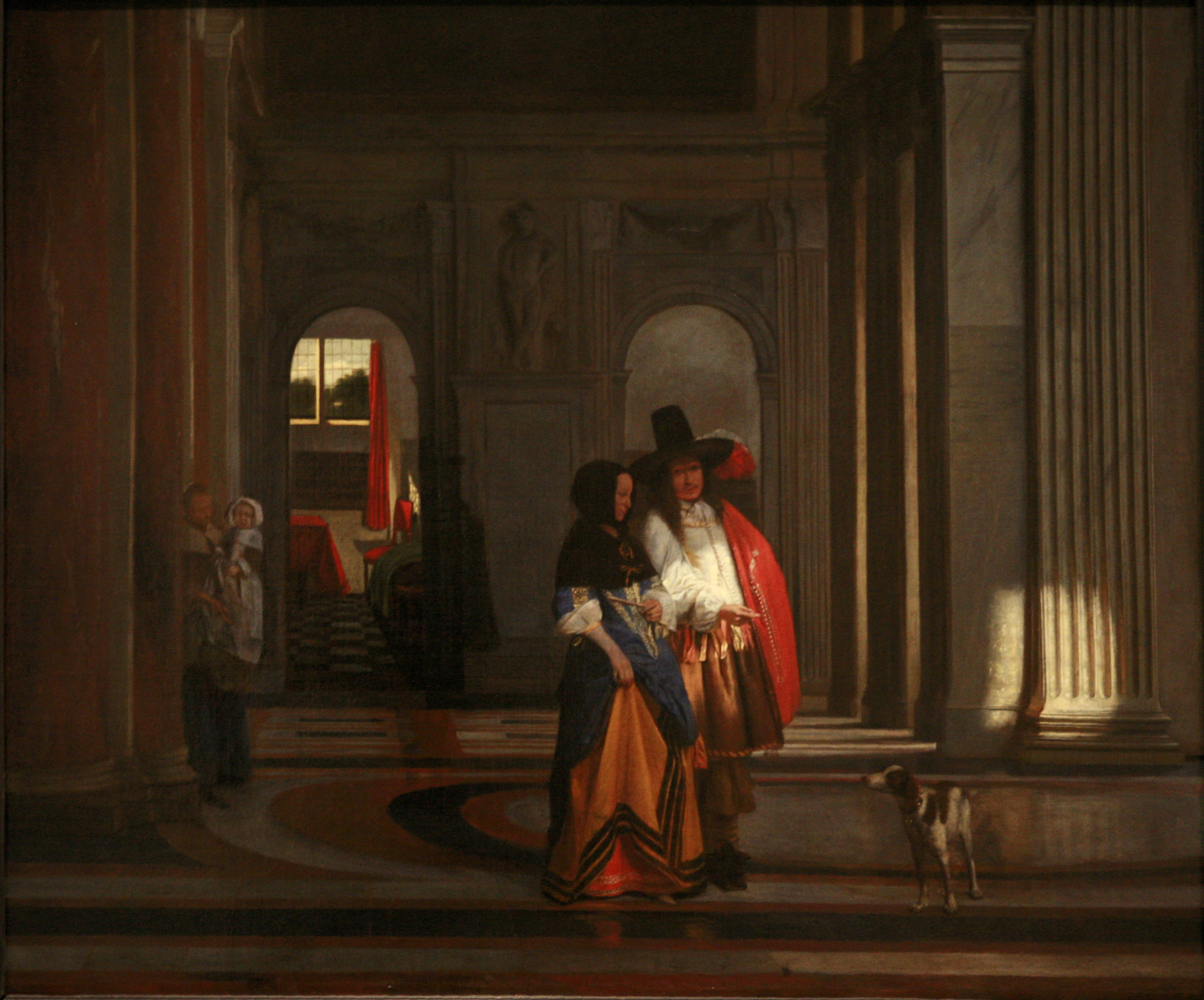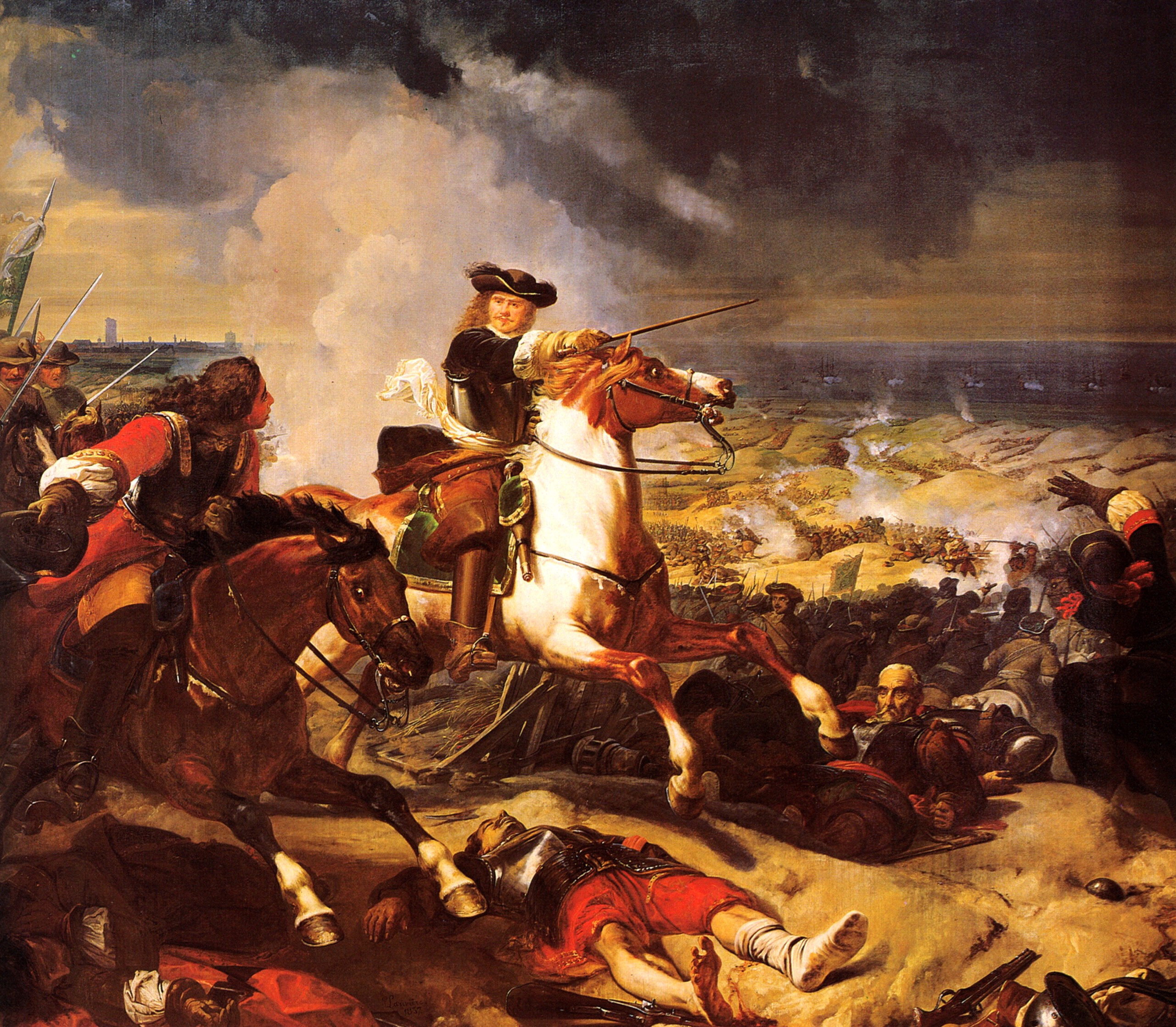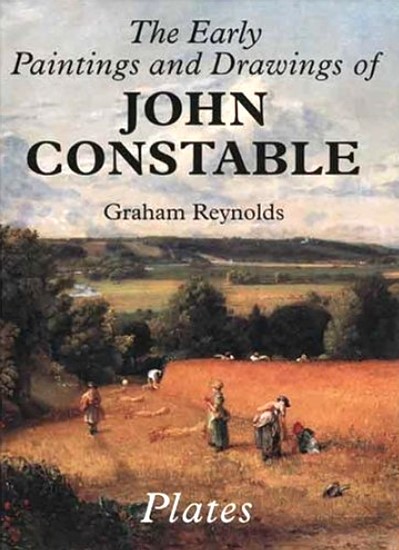|
Courtyard Of A House In Delft
''The Courtyard of a House in Delft'' is a 1658 painting in the National Gallery, London made in the Dutch Golden Age by Pieter de Hooch. The painting portrays domestic architecture typical of de Hooch's middle period; the details and textures of the building and courtyard are given as much or more of the artist's attention as the people. It is signed and dated to the left on the archway "P.D.H. / A 1658". The scene is divided into two pieces. To the left, an archway of brick and stone leads from a paved courtyard a passageway though a house, where a woman dressed in black and red stands looking away to the street beyond. A stone tablet above the doorway was originally over the entrance of the in Delft. It reads, in Dutch: "Dit is in sint hieronimus daelle / wildt v tot pacientie en lydtsaemheijt begeeven / vvand wij muetten eerst daellen / willen wy worden verheeven 1614" (in English: "This is in Saint Jerome's dale / please be patient and meek / for we must first descen ... [...More Info...] [...Related Items...] OR: [Wikipedia] [Google] [Baidu] |
Pieter De Hooch
Pieter de Hooch (, also spelled "Hoogh" or "Hooghe"; 20 December 1629 (baptized) – 24 March 1684 (buried)) was a Dutch Golden Age painter famous for his genre works of quiet domestic scenes with an open doorway. He was a contemporary of Jan Vermeer in the Delft Guild of St. Luke, with whom his work shares themes and style. Biography De Hooch was born in Rotterdam to Hendrick Hendricksz de Hooch, a bricklayer, and Annetge Pieters, a midwife. He was the eldest of five children and outlived all of his siblings. Little is known of his early life and most archival evidence suggests he worked in Rotterdam, Delft, and Amsterdam. According to his first biographer Arnold Houbraken, he studied art in Haarlem under the landscape painter Nicolaes Berchem at the same time as Jacob Ochtervelt and was known for his "kamergezichten" or "room-views" with ladies and gentlemen in conversation. [...More Info...] [...Related Items...] OR: [Wikipedia] [Google] [Baidu] |
John Smith (art Historian)
John Smith (1781–1855) was a 19th-century British art dealer who developed the concept of the catalogue raisonné. Smith was born in London. He began dealing in art as a framemaker, specializing in wood-carving and gilding.Review of book about Smith on He became an art dealer and art consultant known for his "reasoned catalog" of painters that he wrote in 8 volumes and sold by subscription to his art clients during the years 1829 to 1837, and to which he added a 9th volume as a supplement in 1842. Sources * Volume 1 (1829): , Pieter van Slingelant, |
Paintings By Pieter De Hooch
Painting is the practice of applying paint, pigment, color or other medium to a solid surface (called the "matrix" or "support"). The medium is commonly applied to the base with a brush, but other implements, such as knives, sponges, and airbrushes, can be used. In art, the term ''painting ''describes both the act and the result of the action (the final work is called "a painting"). The support for paintings includes such surfaces as walls, paper, canvas, wood, glass, lacquer, pottery, leaf, copper and concrete, and the painting may incorporate multiple other materials, including sand, clay, paper, plaster, gold leaf, and even whole objects. Painting is an important form in the visual arts, bringing in elements such as drawing, composition, gesture (as in gestural painting), narration (as in narrative art), and abstraction (as in abstract art). Paintings can be naturalistic and representational (as in still life and landscape painting), photographic, abstract, narrative, sy ... [...More Info...] [...Related Items...] OR: [Wikipedia] [Google] [Baidu] |
1658 Paintings
Events January–March * January 13 – Edward Sexby, who had plotted against Oliver Cromwell, dies in the Tower of London. * January 30 – The " March Across the Belts" (''Tåget över Bält''), Sweden's use of winter weather to send troops across the waters of the Danish straits at a time when winter has turned them to ice, begins. Within 17 days, Sweden's King Karl X Gustav leads troops across the ice belts to capture six of Denmark's islands as Swedish territory. * February 5 – Prince Muhi al-Din Muhammad, one of the sons of India's Mughal, Emperor Shah Jahan, proclaims himself Emperor after Jahan names Muhi's older brother, Dara Shikoh, as regent, and departs from Aurangabad with troops. * February 6 – Swedish troops of Charles X Gustav of Sweden cross The Great Belt in Denmark, over frozen sea. * March 8 (February 26 OS) – The peace between Sweden and Denmark is concluded in Roskilde by the Treaty of Roskilde, under which ... [...More Info...] [...Related Items...] OR: [Wikipedia] [Google] [Baidu] |
Cambridge University Press
Cambridge University Press is the university press of the University of Cambridge. Granted letters patent by Henry VIII of England, King Henry VIII in 1534, it is the oldest university press A university press is an academic publishing house specializing in monographs and scholarly journals. Most are nonprofit organizations and an integral component of a large research university. They publish work that has been reviewed by schola ... in the world. It is also the King's Printer. Cambridge University Press is a department of the University of Cambridge and is both an academic and educational publisher. It became part of Cambridge University Press & Assessment, following a merger with Cambridge Assessment in 2021. With a global sales presence, publishing hubs, and offices in more than 40 Country, countries, it publishes over 50,000 titles by authors from over 100 countries. Its publishing includes more than 380 academic journals, monographs, reference works, school and uni ... [...More Info...] [...Related Items...] OR: [Wikipedia] [Google] [Baidu] |
Derek Mahon
Derek Mahon (23 November 1941 – 1 October 2020) was an Irish poet. He was born in Belfast, Northern Ireland but lived in a number of cities around the world. At his death it was noted that his, "influence in the Irish poetry community, literary world and society at large, and his legacy, is immense". President of Ireland Michael D Higgins said of Mahon; "he shared with his northern peers the capacity to link the classical and the contemporary but he brought also an edge that was unsparing of cruelty and wickedness." Biography Derek Mahon was born on 23 November 1941 as the only child of Ulster Protestant working-class parents. His father and grandfather worked at Harland and Wolff while his mother worked at a local flax mill. During his childhood, he claims he was something of a solitary dreamer, comfortable with his own company yet aware of the world around him. Interested in literature from an early age, he attended Skegoneill Primary school and then the Royal Belfast Aca ... [...More Info...] [...Related Items...] OR: [Wikipedia] [Google] [Baidu] |
Sir Robert Peel, 3rd Baronet
Sir Robert Peel, 3rd Baronet, GCB, PC (4 May 1822 – 9 May 1895) was a British Peelite, Liberal and from 1884 until 1886 Conservative Member of Parliament (MP). Eldest son of the prime minister Robert Peel, he was educated at Harrow and Christ Church, Oxford and entered the Diplomatic Service in 1844. He served as co-member for Tamworth, his father's constituency, from 1850 until 1880, for Huntingdon from 1884 and for Blackburn from 1885 to 1886. He was appointed Irish secretary in 1861 in Palmerston's ministry, but in 1865, under Russell he was replaced by Chichester Fortescue. He was appointed a GCB in 1866. His variety of parties and tendency not to toe the party line saw republication of a charge of moral want, volatility and 'lack of dignity' from pre- Liberal landslide biographies after his death such as the ''Oxford Dictionary of National Biography'' which mention signs of general profligacy and of his rift from his wife. Background and education Born i ... [...More Info...] [...Related Items...] OR: [Wikipedia] [Google] [Baidu] |
Paul Adolphe Rajon
Paul-Adolphe Rajon (1843 – 8 June 1888) was a French painter and printmaker, who started his career as a photographer. Early life Born at Dijon, Rajon was the third child of Jean Marie Rajon, a hairdresser, by his marriage with Caroline Jaugey, a shop girl some thirty years younger. They had a daughter, Marguerite, born in 1839, and another son, Charles Henri, born in 1840. He died on 8 June 1888 at Auvers-sur-Oise, of pneumonia. Selected works File:Félix Bracquemond by Paul Rajon.jpg, Portrait of Félix Bracquemond (1878) File:Paul Adolphe Rajon - Portrait of Henry Walters - Walters 372545.jpg, portrait of Henry Walters Henry Walters (September 26, 1848 – November 30, 1931) was noted as an art collector and philanthropist, a founder of the Walters Art Gallery (now the Walters Art Museum) in Baltimore, Maryland, which he donated to the city in his 1931 will f ..., 1886. File:Paul Adolphe Rajon - Portrait of William T Walters - Walters 372542.jpg, portrait of William T. ... [...More Info...] [...Related Items...] OR: [Wikipedia] [Google] [Baidu] |
Robert Peel
Sir Robert Peel, 2nd Baronet, (5 February 1788 – 2 July 1850) was a British Conservative statesman who served twice as Prime Minister of the United Kingdom (1834–1835 and 1841–1846) simultaneously serving as Chancellor of the Exchequer (1834–1835) and twice as Home Secretary (1822–1827 and 1828–1830). He is regarded as the father of modern British policing, owing to his founding of the Metropolitan Police Service. Peel was one of the founders of the modern Conservative Party. The son of a wealthy textile manufacturer and politician, Peel was the first prime minister from an industrial business background. He earned a double first in classics and mathematics from Christ Church, Oxford. He entered the House of Commons in 1809, and became a rising star in the Tory Party. Peel entered the Cabinet as Home Secretary (1822–1827), where he reformed and liberalised the criminal law and created the modern police force, leading to a new type of officer known in tribute to ... [...More Info...] [...Related Items...] OR: [Wikipedia] [Google] [Baidu] |
Oud Holland
''Oud Holland – Journal for Art of the Low Countries'' is a quarterly peer-reviewed academic journal covering art from the (Northern) Netherlands and Southern Netherlands (Belgium) from c. 1400–1920. Oud Holland is the oldest surviving art-historical journal in the world. It was founded by Adriaan de Vries and Nicolaas de Roever in 1883, since then 132 volumes have appeared. From 1972 the journal has been published by the RKD – Netherlands Institute for Art History; since 2008 in collaboration with Brill Publishers Brill Academic Publishers (known as E. J. Brill, Koninklijke Brill, Brill ()) is a Dutch international academic publisher founded in 1683 in Leiden, Netherlands. With offices in Leiden, Boston, Paderborn and Singapore, Brill today publishes 27 .... The editorial board consists of Elmer Kolfin (editor-in-chief), Menno Jonker (managing editor), John Bezold (online review editor), Jan Dirk Baetens, Yvonne Bleyerveld, Edwin Buijsen, Nils Büttner, Volker Manuth, T ... [...More Info...] [...Related Items...] OR: [Wikipedia] [Google] [Baidu] |
Catalogue Raisonné
A ''catalogue raisonné'' (or critical catalogue) is a comprehensive, annotated listing of all the known artworks by an artist either in a particular medium or all media. The works are described in such a way that they may be reliably identified by third parties, and such listings play an important role in authentification. Etymology The term ''catalogue raisonné'' is French, meaning "reasoned catalogue"Catalogue raisonné , ''Online Merriam-Webster Dictionary''. (i.e. containing arguments for the information given, such as attributions), but is part of the of the English-speaking art world. The spelling is never Americanized to "catalog", even ... [...More Info...] [...Related Items...] OR: [Wikipedia] [Google] [Baidu] |
Hofstede De Groot
Cornelis Hofstede de Groot (9 November 1863 – 14 April 1930), was a Dutch art collector, art historian and museum curator. Life He was born in Dwingeloo and spent some time in Switzerland in his youth due to weak lungs, where he learned German. He became the first academically schooled art historian of the Netherlands, receiving his training in Leipzig, which is why much of his work was published in German, most notably his lengthy 10-part ''Beschreibendes kritisches Verzeichnis der Werke der hervorragendsten Holländischen Mahler des XVII. Jahrhunderts'' (1907–28), also known as a rewrite of John Smith's ''catalogue raisonné'' (9 vols.; 1829–42, London). He became an expert who had many differences of opinion with Abraham Bredius and other art collectors, while serving various institutions to do with the arts of the Netherlands, including the Frans Hals Museum, Gemeentemuseum Den Haag, and the RKD. In 1893 he published a short article on Judith Leyster in the jo ... [...More Info...] [...Related Items...] OR: [Wikipedia] [Google] [Baidu] |









